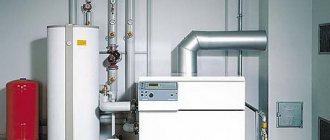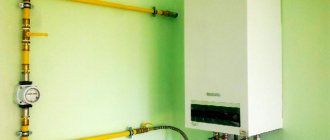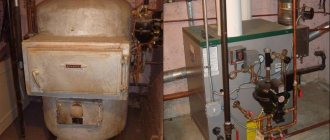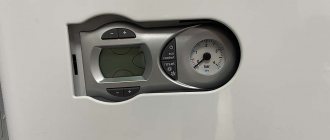A UPS for a gas boiler is not a cheap thing, so a reasonable question arises for the economical homeowner: why do you need an uninterruptible power supply? The fact is that modern gas equipment is increasingly designed to be energy-dependent and equipped with sophisticated electronics designed to make our lives easier. All kinds of control systems, ignition, program control and other functions require uninterrupted electrical power. In addition, of course, electronic components are sensitive to sudden voltage changes.
Emergency situations leading to power outages and power surges will most likely lead to failure of your heat generating device. Being left without heating in a private country house is an unpleasant prospect. Not only will household members experience severe discomfort, but even worse, all plumbing equipment - pipes, radiators, water supply systems - will become completely unusable as a result of negative temperatures.
Avoiding such a catastrophe is quite simple if a prudent owner thinks in advance which uninterruptible power supply (UPS) for a gas boiler will provide him with complete protection from unforeseen situations. Needless to say, the uninterruptible power supply for a gas boiler will retain warranty service?
It is necessary to take into account that when there are surges in the network, first of all, electronic elements fail, but the reason “unstable electrical network” is always interpreted by the service center as not a warranty case. So, we believe that the question of the need to install a UPS, UPS, or, more simply, an uninterruptible power supply, is closed.
Note that UPS for gas boilers are presented in a huge range and are divided into three main types. We will look at what knowledge we need to choose the best uninterruptible power supply in our review.
At the end of the review, we will bring to your attention the most popular models of uninterruptible power supplies in demand in the domestic market. Let's take a look at the Internet and read some customer reviews about the experience of using the UPS. And about how to correctly connect a UPS with your own hands.
Which boiler elements depend on electricity?
Power outages to houses not only in the outback, but also in cities occur quite often.
They happen due to emergencies, planned repairs and technical work, and breakdowns on the line. And the most unpleasant thing is that when the electricity is turned off, the operation of the gas boiler is paralyzed if it is of the volatile type. The non-volatile gas boiler continues to function as usual, even if there is a power outage on the power line. The only exception is if a pump works in conjunction with it, and a gravitational coolant circulation system is not provided.
Non-volatile boilers have the simplest, basic set of functions. They are less comfortable to use than their energy-dependent counterparts. But their operation is absolutely independent of energy supplies to the home electrical network, and they are less likely to fail
In a heating circuit with a boiler of the simplest type, the set of basic elements is something like this:
- smoke removal system with natural draft;
- heat exchanger;
- gas burner with nozzles for supplying gas, which is located in the combustion chamber;
- gas supply and ignition unit;
- expansion tank;
- mechanical temperature sensor;
- control module, which includes a boiler ignition system (mechanical or piezo), temperature control;
- safety group (safety valve, pressure gauge, air vent).
Volatile devices are more complex in design. But is electricity really necessary and important for the operation of a gas boiler?
Depending on the model and brand, in addition to the same basic set of elements, in some cases electronic and automatic, they may provide such functions as:
- forced ventilation system;
- built-in circulation pump;
- electronic system control module;
- shut-off and control valves with electric drive;
- various sensors - water flow, temperature, flame supply, water pressure in systems, manostat, emergency complexes;
- piezo ignition unit with electric drive;
- automatic temperature regulators;
- notification and remote control system;
- display showing the current performance indicators of the device
Units of this type are more reliable and much more convenient to use, and in addition, they are economical. You can set the automation to turn on and off, reducing fuel consumption, create a comfortable microclimate at home, and not worry about safety and performance.
Modern boilers are crammed with electronics. When choosing a device, also install a voltage stabilizer to protect against surges in the network
The only negative is that after a power outage, the volatile gas boiler will not be able to fully operate. It is difficult to say which functions will be completely absent; it depends on the boiler model. Some units have a combined control system - mechanical and electronic.
It is certain that forced ventilation, automatic adjustment of the flame supply to the burner, pump, display, electronic control module, in general, all devices operating on an electric drive and a constant current supply will not function.
But is everything so scary?
Solid fuel boilers
Without a doubt, these units (as well as fireplaces with a water circuit) can be called the least protected from troubles associated with a power outage. True, as practice shows, it is precisely this type of equipment that is most often used in open or gravitational, that is, completely energy-independent heating systems. However, this heating method has not become widespread due to a number of serious disadvantages, among which are the large diameter of the pipes and the complete inability to supply heat to rooms located below the boiler room. Well, when using circulation pumps, a power outage for a solid fuel unit is like death. If, as can be seen from the above, devices of any other type can be stopped quickly enough to prevent overheating of the liquid in the heat exchanger, then wood or pellet analogues do not allow anything like this to be done. Even by closing the corresponding damper and stopping (or rather, limiting) the air supply to the firebox, it will not be possible to quickly extinguish the fire, and basic common sense dictates that it is impossible to douse the flame with water. As a result, the owner of the unit will have to at least replace the heat exchanger, and experts say that it is almost impossible to prevent such an outcome.
The conclusion from all that has been said suggests itself: while there is no centralized power supply, it is necessary to provide for the possibility of autonomous power supply for the elements of the heating system, organized on the basis of a gasoline or diesel generator or an uninterruptible power supply (UPS).
Electric boilers.
Everything here is quite obvious: the unit turns off simultaneously with all auxiliary devices. No problems arise in this case, which distinguishes this type of heat generator from other analogues from the point of view of safety during operation.
Liquid fuel boilers.
Theoretically, they also do not pose any threat, even taking into account the disabling of all automation. The fuel pump will stop functioning, which will stop the supply of diesel fuel (fuel oil, waste oil, etc.) to the burner, which will quickly exhaust the remaining fuel and go out. In practice, this inertia of the device can lead to overheating of the liquid in the heat exchanger and cause its damage, albeit minor, but which will affect the efficiency of the boiler in the future.
Gas boilers.
The main difficulty that awaits such equipment during a power outage is that the supply of natural gas to the burner is an energy-independent process. That is, the control and safety automation becomes completely incapacitated, and the fuel continues to flow and burn in the corresponding boiler chamber; after such words, some people have a desire to buy a non-volatile boiler .
We recommend: Do-it-yourself installation of decking boards: step-by-step instructions
What could this lead to? Let us remind you that the circulation pump, as well as the flow sensors, water temperature and flame presence, do not work. The liquid inside the heat exchanger quickly heats up and is brought to a boil, while literally tearing the tubes of the device, entering the combustion chamber under pressure. If an atmospheric burner is installed here, then it will most likely be flooded, that is, the flame will go out, the de-energized controller will not be able to issue a command to re-ignite, and in the meantime, the gas supplied to the burner will freely penetrate into the room where the boiler is installed.
A somewhat less catastrophic situation will arise in the case of a supercharged (fan) model. Without the air flow necessary to prepare the gas-air mixture and provided by electric fans, the fire will quickly die out (however, it will probably have time to damage the heat exchanger). However, a closed combustion chamber will not allow uncontrolled gas to leak into the boiler room: it will be discharged through the chimney to the street, which, however, can also have the most negative consequences.
To avoid them, the security automation includes only one device, which is perhaps the most important element of this system. We are talking about a gas cutoff
, also called a shut-off valve. If the slightest malfunction occurs (including a power outage), this device instantly cuts off the fuel supply to the burner. The design is truly elementary: the shut-off valve, which is normally closed, consists of an inductive coil with a core on which the valve cover is fixed. The magnetic field generated in the coil by the applied voltage causes the core to move upward, lifting and holding the valve cover in the “open” position. As soon as the voltage disappears, for any reason, be it a command from the controller or a general power outage, the core, under the action of the return spring and the valve cover’s own weight, falls down, pressing it to the saddle and cutting off the gas supply to the burner.
The device does not require maintenance and must be replaced only upon failure, however, during each maintenance (MOT) of the system, the shut-off device must be checked for the speed of operation and the tightness of the valve cover to the saddle. Simply put, it turns out how quickly and effectively the device in question can shut off the fuel supply.
Selecting the type of stabilizer
Stabilizers differ in many ways. For example, units can be located on the walls of the room (wall-mounted) or on the floor (floor-mounted). The industry produces stabilizers operating from direct or alternating current, single-phase or three-phase.
Stabilizers use several methods of switching windings; according to this principle, units are usually subdivided: With a servo drive (electromechanical stabilizers) - a slider moves along the windings of the unit using a servo drive. This type of stabilizer is made like a car transformer. Electromechanical stabilizers operate thanks to built-in devices that ensure the operation of the transformer.
Schematic: servo stabilizer
The advantages of an electromechanical stabilizer include:
- gradual voltage regulation without causing phase disturbances and reducing the current sinusoid;
- small dimensions;
- high preservation of performance at various voltages, including moments of voltage surges from 100 to 120V.
Relay (electronic) - in this design, the windings are switched using a relay. At a low cost, such units have sufficient reliability and quality. The closed sealed housing of the relay stabilizers prevents the penetration of dust and moisture into the structure.
Relay voltage stabilizer
The advantages of relay stabilizers are:
- relay stabilizers do not require maintenance;
- speed of reaction;
- high switching speed when the input signal changes;
- profitability - the units are low cost.
Attention! A significant disadvantage of electronic units is the stepwise regulation of the output voltage, which significantly reduces their use.
In the design of a triac voltage stabilizer, relays and triacs are used together. The advantages of stabilizers of this type are:
Triac voltage stabilizer
- triac voltage stabilizers do not contain parts in the design of the unit that wear out during mechanical operation, which distinguishes them from relay and electromechanical stabilizers;
- these units are characterized by high durability and reliability;
- triac units are available in floor-mounted and wall-mounted versions;
- complete silent operation of the unit;
- during short-term power failures or overloads, a triac stabilizer guarantees uninterrupted operation of household appliances, including a gas boiler;
Diagram: operation of a triac voltage stabilizer
- the system is equipped with built-in multi-level automatic protection, which provides load shutdown in case of overcurrent, protection against short circuits, protection against excessively high and low voltage;
- The service life of the device, established by the manufacturers, is up to 10 years.
Thyristor. Stabilizers of this design have thyristor switches, which, when turned on or off, can affect the sinusoidal shape of the current, causing its distortion. The algorithm for measuring voltage several tens of times and determining the moment when the thyristors are turned on is determined taking into account the algorithm for changing the voltage in a few fractions of a second. Turning the thyristors on or off is controlled by a processor built into the circuit.
Tristor voltage stabilizer
Thyristor stabilizers are not at risk of overload in the event of emergency situations occurring on power supply networks—the microcontroller immediately sends a command to turn off the stabilizer.
The advantages of thyristor stabilizers are:
- noiselessness during operation of the current conversion unit;
- durability - the thyristor can operate more than 1 billion times;
- no arc discharge is formed when thyristors operate;
- efficiency in energy consumption;
- small overall dimensions;
Circuit: tristor voltage stabilizer
- Lightning speed and accuracy when leveling and normalizing voltage;
- operating range at voltage levels from 120 to 300 volts.
Despite the extensive list of advantages of a thyristor stabilizer, the unit is not without some disadvantages:
- stepwise method of current stabilization;
- high cost - this is the most expensive stabilizer of all existing on the market today.
Are power outages dangerous?
Sellers of non-volatile appliances and uninterruptible power supplies tell customers chilling stories that look quite plausible. A person who does not understand anything at all about the design of a boiler will believe that if the current is lost, the gas supply to the burner continues.
What's really going on? When the temperature sensors, electronic control unit and pump are turned off, uncontrolled combustion of fuel occurs in the combustion chamber, which means overheating of the liquid in the heat exchanger.
Accordingly, the tubes cannot withstand, they become deformed, burst, and the water from them extinguishes the burner of the atmospheric gas boiler. Gas enters the room and creates an explosive situation or simply poisons people and animals. And if a forced-air ventilation system is installed in the boiler, go outside. This is also unsafe and not environmentally friendly.
Do you agree that it sounds plausible and scary? Have you already decided to run for a non-volatile boiler? But in vain!
Do not avoid performing maintenance on gas appliances and their components. Checking will show their performance, especially after power outages
In fact, electrically dependent boilers occupy a leading position in the sales market. They are installed in holiday villages, private houses, with owners spending half a day at work, and in non-residential premises where long-term repairs are being carried out.
Power outages, as mentioned earlier, are quite common. And for some reason there is no data on hourly large-scale tragedies of carbon monoxide poisoning or explosions.
Moreover, such a dangerous device would not be certified and could not in any way comply with GOST, which means that gas workers would not allow it to be used.
And now the technical details. In fact, the devices have a reliable system that ensures that the boiler is turned off in the event of force majeure, including a power outage.
Recommendations for use
- If the gas valve malfunctions, it is necessary to check it and adjust the settings. If the heat exchanger is covered with a large layer of scale, this greatly reduces heat transfer and significantly increases fuel consumption. In such a situation, the boiler makes a cracking or noise. This occurs due to the accumulation of salts, which slowly fall off the surface over time, which is why the noise is heard. They can be removed using special reagents.
- Often you have to deal with components wearing out too quickly. The main reason for this is timing. In this case, the gas boiler can automatically turn on and off. When the water in the circuit cools down, a signal is received from the thermostat that the water has cooled, in which case the boiler turns on.
To learn how to choose a gas boiler, see the following video.
What happens after power supply is restored?
One of the most pressing questions for consumers is whether a volatile gas boiler will turn on automatically after a power outage?
Depending on the boiler model, after the electricity is reconnected, it may ignite automatically or only after manual starting. Devices with piezo ignition will require mechanical activation.
Devices with an atmospheric burner, as well as units with the above-mentioned pressurized system, are able to turn on independently, and even without losing the set automatic parameters, if they are equipped with electric ignition and a pressure switch.
However, auto-start does not always work either. After a large number of subscribers have lost power, when electricity is restored, the pressure in the gas pipeline may drop for some time; accordingly, the pressure switch is triggered, the equipment does not turn on, and then it can only be started manually.
We recommend: TEPLOCOM voltage stabilizers: photos, characteristics
For those for whom this issue is relevant, it is enough to install a delay relay or, as it is also called, a “time relay”. Then your boiler will not start immediately, but after some time, when the pressure in the gas pipeline is likely to equalize.
A time relay allows you to delay the automatic activation of electric ignition until the gas pressure is expected to equalize
In some cases, the electronic control module displays an error after power is supplied. This means that a minor emergency occurred before the shutdown. The decoding of the code can be found in the instructions for the heating device.
By the way, not all of them can be fixed on their own; to solve certain problems, you will need to call a specialist from GorGaz or the service department.
"Pump run-on"
After the water heating in the boiler stops, the burner turns off. If at this moment the boiler pump also turns off, then due to high inertia, the temperature of the heat exchanger may increase above the permissible level, which may lead to the activation of the thermal protection (safety valve). The “pump run-on” function is designed to prevent this.
In some boilers, this function also works before turning on the burner in order to equalize the temperature of the coolant, preventing clocking.
Photo: Boiler pump run-out
Pump run-on time
The pump run-on is set as standard for 4 minutes after the end of the heating demand. If desired, this parameter can be changed by specialists in up to 20 minutes, depending on the brand and model of the boiler.
How to deal with periodic power outages?
In regions remote from large cities, this is a common problem. And in order not to worry about what will happen to the boiler if the power goes out, there are two solutions.
Solution #1. Generator
This option is more suitable for country houses and in general is not particularly convenient. Yes, generators provide good autonomy, but they are inconvenient. It is imperative to take care of proper exhaust gas removal. Plus, generators make a lot of noise during operation. Therefore, we cannot recommend this solution to everyone.
Solution #2. Uninterruptable power source
Modern UPS models allow the boiler to operate autonomously from 1 hour to several days. Plus, they act as a stabilizer, which also solves the problem of power surges. The built-in stabilizer evens out even minimal surges, and thanks to the ability to connect multiple batteries, very high autonomy can be achieved. Plus, the stabilizer ensures safety for the batteries themselves during charging. Thus, the service life of the system is significantly increased.
How to choose a backup power source?
The most popular option is an uninterruptible power supply, abbreviated as UPS. It provides a secondary power supply to the device in case of a short-term power outage on the line.
Most often, it is used to provide power to a computer so that a person has time to finalize, save information and exit the system in normal mode in the event of a power outage from the main source.
Of course, a regular uninterruptible power supply from a computer is not suitable for a gas boiler. The maximum that he can do is extend the functionality of the device by 2-3 minutes, since the output produces an approximation of a sine wave or a square wave, and the boiler requires a pure sine wave. Please take this into account when purchasing a device.
A competent choice of UPS for the boiler will allow you to ensure fuel supply even when there is a power outage on the line
Ideally, an uninterruptible power supply with a power of 300-600 W is suitable, with the ability to connect a battery up to 600 Ah. The capacity of such a battery will last for 3 days.
But if for some reason you want to save money, keep in mind that:
- 50-100 Ah, will extend the operation of the boiler for a period of 3 to 8 hours;
- 200 A*h is enough for about a day of uninterrupted functionality.
Outages longer than a day require a more powerful power source. And here it is best to choose an inverter gasoline generator, which also has a pure sine wave. With the help of these devices, the gas boiler will operate in a stable mode after the load is turned off.
Types of independent gas boilers
The following types of boilers operating without electricity can be distinguished:
- single-circuit
- apply only to the heating system; - double-circuit
- these are devices that, in addition to heating, also provide hot water for household needs.
Rice.
1 Double-circuit boiler with a boiler connected to the system Double-circuit gas boilers, in turn, provide hot water in 2 ways: flow-through and storage.
Can electricity be cut off in winter due to accumulated debt?
In this case, the consumer must be notified in writing at least 10 days before the expected date of introduction of the restriction (power outage).
All the reasons why the supply of electricity is interrupted, not counting the termination of the contract between the supplier and the consumer, can be divided into two groups: technical and economic.
I live in Crimea, in Feodosia. When dialing a number, the phone immediately turns off. And the question: A transit riser (MCD) passes through the apartment. The apartments have individual heating. The first floor is a branch of the State Treasury, which, in the process of an uncoordinated renovation, flooded us on the 3rd and 2nd floors with twice-cold water and after 4 four days with hot water. The downstairs neighbor was persuaded to make me the defendant. Who is the owner of the transit pipe?
Selecting an independent boiler model
Gas boilers operating without electricity must fully correspond to the area of the heated room. That is, the power must match the load.
Double-circuit models from foreign manufacturing companies are often more expensive than domestic ones, as they are more advanced and have an attractive design. The manufacturer of the gas boiler must be chosen carefully; it is important to make sure that this company has a service center in the city or nearby. Since, if necessary, you can find spare parts for repairing the device there.
The most popular manufacturers of such equipment are Alphatherm, Beretta - Italy, Attack - Slovakia, Protherm - Czech Republic, Electrolux - Sweden.
Rice. 2 Boiler without electricity from Protherm
Domestic models of independent boilers are cheaper than foreign ones, but are considered less reliable. But we should pay tribute that such devices are already adapted to our weather conditions and the parameters under which they must operate.
A gas boiler without electricity can be chosen with a steel or cast iron heat exchanger. The most popular are cast iron devices. This is explained by the service life: cast iron will last 30 years, and steel 15-20 years.
Cast iron is not only stronger, but the design also means that the walls of such a heat exchanger are thicker. This prevents the walls of the heat exchanger from burning through. This device has been tested in practice.
The heat exchanger may also be subject to corrosion. A cast iron appliance is much less susceptible to such damage than steel. Corrosion on the heat exchanger appears if the temperature drops to the point that condensation appears. And this very moisture leads to corrosion processes.
Also, the cast iron heat exchanger, by its design, consists of sections. If necessary, you can change a section, not the entire device. Nowadays, impurities are added to the cast iron alloy, which make it even stronger. This means that it will not crack if transported incorrectly.
Gas shut-off safety devices
As part of the automation of a gas boiler, a shut-off valve, popularly called simply a cut-off valve, is often used as a fast-acting shut-off system. Unlike other shut-off valves, the valve operates automatically.
Its main purpose is to supply gas to the burner with the required pressure at a given power and completely stop the fuel supply in the event of a malfunction. This process is carried out using monitoring devices with built-in sensors.
Automation differs in the type of ignition - there are piezo ignition and electric ignition.
Piezo ignition is when the start is done manually by pressing a button. It controls the operation of the flame - a thermocouple, which is heated by the igniter and, generating a direct current, ensures the open state of the valve.
As soon as, for some reason, the pilot burner stops supplying an open flame, the solenoid valve closes and the gas flow stops. Piezo ignition is an energy-dependent element of automation.
The electric ignition unit is connected to the power supply. Starting is carried out from an electric spark in automatic mode. This system is volatile and when the current is turned off, the valve of the device shuts off the gas supply.
It looks something like this. The differential relay has two contacts. During normal operation of the heater, one block is closed. When any change occurs in the operation of the boiler, for example, the power is turned off, the second unit is activated, and the first one opens. The relay moves, the membrane bends and the gas supply is cut off.
Advantages and disadvantages
The advantages of non-volatile boilers include:
- there is no dependence on the availability and quality of power supply;
- simplicity of design, absence of minor parts;
- guaranteed continuity of the home heating process;
- the cost of the boiler and repair work is significantly lower than that of energy-dependent models;
- You can do maintenance and cleaning yourself.
Disadvantages are considered to be:
- the protection system is limited to several sensors;
- there is no possibility of remote control;
- The operation of the boiler depends on external factors that cannot be adjusted.
IMPORTANT!
Despite some disadvantages, non-volatile boilers are a practical and reliable solution. In some settlements they have no competitors due to power outages.
Top 4. CROWN MICRO CMU-1000X
Rating (2021): 4.66
Compact UPS equipped with a lot of protective functions. An interactive type system is used here, but due to the rapid transition to autonomous sources, the donor practically does not notice the changes. During periods of inactivity, the device consumes virtually no electricity and is considered one of the most economical. It has its own stabilizer on board, protecting the network from sudden changes. It can level out the current when it drops to 110 watts and when it rises to 280 watts. This range means that the transition to offline mode will only occur in truly extreme situations, and not at the slightest surge, as is often the case with other UPSs.
Characteristics:
4,700 rub. / USA (manufactured in China) / Operating principle: interactive
Rating of TOP-5 energy-independent gas boilers
Let's look at the features of some models of non-volatile units:
Lemax Premium-12.5
Non-volatile floor-standing boiler of domestic production. The power of the unit is 12.5 kW, so the area of the room should not exceed 125 square meters. m.
The model is equipped with a steel heat exchanger, overheating protection and a gas supply controller.
Main performance characteristics:
- Efficiency - 90%;
- maximum heating water temperature - 90°;
- pressure in the heating circuit (max) - up to 3 Bar;
- natural gas consumption - 1.5 m3/hour;
- dimensions (W-H-D) - 416x744x491 mm;
- weight - 55 kg.
We recommend: Why heating radiators make noise in an apartment: causes and solutions
Lemax provides a long-term warranty on its boilers - the user receives technical support for 3 years.
Lemax Premium-20
Another floor-standing, non-volatile gas boiler, manufactured in Taganrog.
Its power is 20 kW, which is optimal for most private two-story houses. The maximum area for this unit is 200 sq. m.
Boiler parameters:
- Efficiency - 90%;
- maximum heating water temperature - 90°;
- pressure in the heating circuit (max) - up to 3 Bar;
- natural gas consumption - 2.4 m3/hour;
- dimensions (W-H-D) - 556x961x470 mm;
- weight - 78 kg.
The single-circuit design is designed to heat the coolant, but if necessary, you can connect an external indirect heating boiler .
Lemax Patriot-12.5
Energy-independent parapet model from Taganrog. A boiler with specific capabilities.
Non-volatile unit, but the combustion chamber is of a closed type. Boiler power 12.5 kW, suitable for heating 125 sq. m.
Main technical characteristics:
- Efficiency - 87%;
- maximum heating water temperature - 80°;
- pressure in the heating circuit (max) - up to 2 Bar;
- natural gas consumption - 0.75 m3/hour;
- dimensions (W-H-D) - 595x740x360 mm;
- weight - 50 kg.
The main advantage of parapet boilers is their low fuel consumption - almost half that of conventional models.
Siberia 11
Products of Rostov manufacturers of heating equipment. And the units are available in single- and double-circuit versions, which expands the possibilities of choice .
The power is 11.6 kW, allowing you to heat a house up to 125 square meters. m.
Main settings:
- Efficiency - 90%;
- maximum heating water temperature - 90°;
- pressure in the heating circuit (max) - up to Bar;
- natural gas consumption - 1.18 m3/hour;
- dimensions (W-H-D) - 280x850x560 mm;
- weight - 56 kg.
Rostov units are positively assessed by specialists and ordinary users.
MORA-TOP SA 40 G
The Czech gas non-volatile boiler with a power of 35 kW is designed for use in rooms up to 350 sq. m. m. The massive structure is equipped with a cast iron heat exchanger.
Options:
- Efficiency - 92%;
- maximum heating water temperature - 85°;
- pressure in the heating circuit (max) - up to Bar;
- natural gas consumption - 3.9 m3/hour;
- dimensions (W-H-D) - 630x845x525 mm;
- weight - 151 kg.
The cast iron heat exchanger has a sectional design of 5 sections . There are pressure and temperature sensors.
Top 2. ELTENA (INELT) One Station 600
Rating (2021): 4.71
Despite its compact dimensions and simple form factor, the One Station 600 UPS is capable of providing the boiler with energy within 15 minutes with an immediate transition to an autonomous source. It uses a redundant type system, but the transition speed is only 3 milliseconds, so the donor device board is not negatively affected by a sudden change in the sine wave. Unfortunately, the battery capacity is quite small, and it is impossible to expand the device’s capacity with additional batteries. There are three outlets at once, each of which has its own grounding.
Characteristics:
RUB 3,800 / Russia / Operating principle: backup
I. UPS with one external battery (12V)
We recommend using models with the connection of one external battery with small heating boilers with a maximum load of up to 300-400 W for short or medium battery life. There are 2 significant models on the market:
1 place. Eltena (Inelt) Monolith E 1000LT-12v ~21,450r.
Eltena with a charge current of 12A and one battery for 100Ah
A new model in the Monolith line from Inelt. A product of the Chinese plant Kehua Tech (www.kehua.com), adapted for the Russian market.
Advantages of the UPS:
- Good input voltage range 110-300V without switching to battery.
- The charging current is 12A, which is relevant when connecting a battery with a capacity of up to 250Ah.
The disadvantages include:
- High price for the device
- New 12V model for the manufacturer
2nd place. Helior Sigma 1 KSL-12V (no longer available in Russia)
This uninterruptible power supply, adapted by our engineers to Russian conditions, manufactured by Helior Corporation (www.heliortec.com) has been consistently ranked first in sales reports for several years now. Reasons for popularity besides affordable price:
- Lowest fan noise level among analogues (rotation speed depends on load)
- There is a special mode of operation from a generator (the permissible range of the input frequency is expanded)
- Compact size and can be used in two positions
- Sufficiently high reliability when working with heating systems
Weaknesses include:
- A relatively narrow range of permissible input voltage values that the source can “pull” without switching to the battery.
- Average charge current, which allows you to connect batteries with a capacity of 30 to 150Ah.
The UPS for powering the heating boiler must have a long reserve
For some reason, along with this point, a computer UPS of the type %Company% Back Power 500 is constantly cited, whose battery has a capacity of 7Ah, and the operating time of the batteries is specially limited by a jumper to 5 minutes, due to the fact that the transformer used during operation the batteries heat up so much that the plastic case is deformed. Despite this, even such a weak UPS can operate for a long time on batteries, you just need to replace the battery with a more capacious one and add active cooling. In my case, such a UPS worked from a car battery for 20 hours, supporting the operation of a PC with a consumption of around 150W. Simply put, the backup time does not depend on the UPS, but on the capacity of the batteries.
Starting currents
The third important point is the starting currents or power that is required to start the equipment. To do this, it is necessary that one important rule be observed: the starting power must be several times higher than the rated power.
But even here it is very important that its value does not exceed the maximum permissible. Otherwise, all parts will wear out much faster, which will cause the UPS to fail ahead of schedule.











